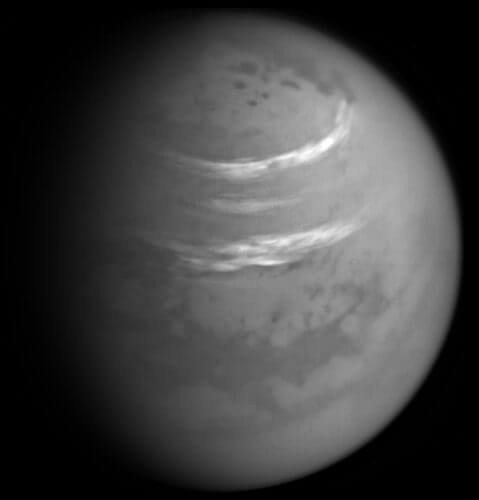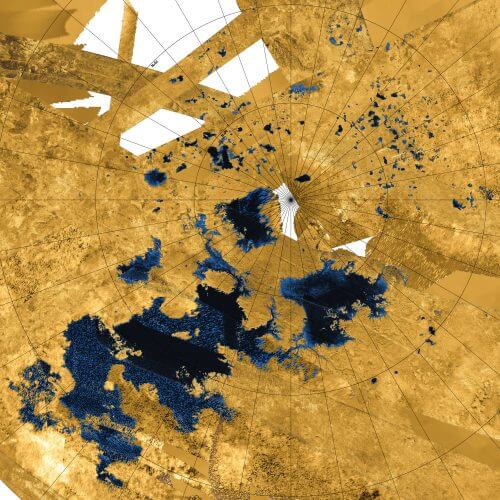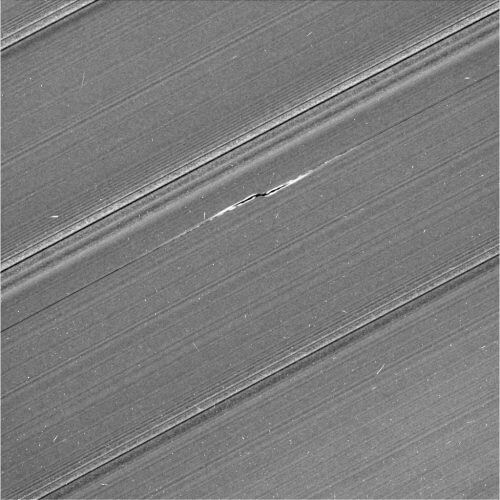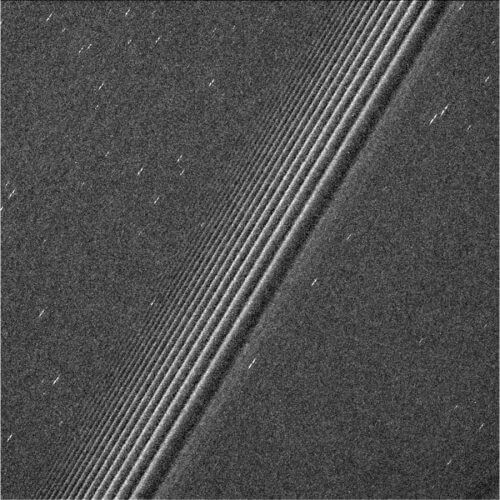The Cassini spacecraft is indeed about to finish its 13-year mission around Saturn, its rings and moons in four months, but until then we can expect many surprises and discoveries from it. Photographs taken recently by the spacecraft reveal the methane clouds on the moon Titan. Another photograph reveals the "propellers" in Saturn's rings, signs created by tiny moons in the rings, reminiscent of an airplane propeller in shape.

Titan's methane cloud activity increases as it approaches the peak of summer in the northern half of the moon
In a new photo by the Cassini spacecraft, three large bands of methane clouds are visible in Titan's northern hemisphere. Titan is the largest moon of Saturn, and the only moon in the solar system that is enveloped in a dense atmosphere. Although most of its atmosphere consists of nitrogen (as on Earth), the element that gives the Moon its great interest is methane, which makes up about 1.4% of the atmosphere. At Titan's great distance from the Sun, 10 times the Earth's distance from the Sun, the temperature on the moon reaches 180 degrees Celsius below zero on average. In this extreme cold, methane behaves like water on Earth, with "Methane cycle", Similar toThe water cycle On Earth - the methane in the atmosphere condenses into clouds, which bring rain and fill the The lakes of the moon, most of which are concentrated in the North Pole.
According to NASA, the clouds in the photo are the largest seen on the moon since clouds began to reappear in its northern regions in 2016. The researchers expected to see increased cloud activity, with the approach toSummer solstice Northern Summer Solstice in the moon, to apply on May 24. This point will mark the beginning of "summer" in the northern half of Titan (which will last 7.5 Earth years), if this season can even be called that, since the largest temperature difference recorded between winter and summer on the frozen moon standing Only about 3.5 degrees Celsius.
The arctic lakes are visible at the top of the image, while the patches below the cloud bands are large dune surfaces of complex hydrocarbons. These substances are formed from methane in the atmosphere, which is broken down by the sun's ultraviolet radiation and assembled into more complex and heavier hydrocarbons.
The same complex hydrocarbons also create the heavy haze that obscures the surface of the Moon in visible light, giving it the Its color is orange. To penetrate through the haze, the photo was taken using an infrared filter.
Cassini took the photo on Sunday, May 7, from a distance of about 500,000 km. Although the spacecraft Has performed After its 127th and final flyby of Titan last month, the spacecraft is still monitoring the moon and its atmosphere from afar.

The recording was made shortly before Cassini successfully made its third dive into the narrow gap between Saturn and its rings. Cassini is now in the final phase of its mission, which is also its most daring since it arrived at Saturn in 2004: the spacecraft's trajectory takes it within the narrow gap, of only a few thousand km, between Saturn itself and its ring belt, an area that has never been explored until now.
The spacecraft, which NASA decided to destroy because its fuel was running out, entered the daring orbit last month, and will perform another 19 dives in the narrow space between Saturn and its rings. In its final dive, on September 15 of this year, the spacecraft will deliberately enter Saturn's atmosphere and burn up in it.
The propellers of Saturn's rings are revealed in unprecedented resolution

In the meantime, NASA published another spectacular photo by Cassini, in which we can see in the highest resolution ever one of the "propellers" in Saturn's rings, which received the nickname due to their shape reminiscent of the propeller of an airplane. The propellers are the product of disturbances in the thin plane of the rings, caused by small moons. The moons, whose average size is only a few hundred meters, are hidden by the tiny ice particles of the rings, which cluster around them.
The propeller pictured is the largest of these bodies, although NASA has not specified its exact size. Similar to the other propellers discovered by the spacecraft and named after aviation pioneers, the propeller received the nickname "Bellerio", after the French aviation pioneer Louis Bellario, who in 1909 was the first to fly across the English Channel.
The photograph was taken from the unlit side of Saturn's rings, where the sun's rays penetrate through the lit side. In this way, when there is a clustering of particles in the rings, sunlight is unable to penetrate through them and the area appears darker. In the photo you can see that inside the propeller there is a darker strip, which indicates that the particles of the rings crystallize near the moon in greater density.

NASA also revealed another photo, showing a large cluster of smaller propellers in the middle region of Saturn's A ring. The propellers are the many bright lines that appear to be crossed in the center. The waves seen in the picture are spiral waves, created by the gravitational interaction between some of Saturn's moons and the rings.
The images were taken last month, shortly before Cassini entered its deadly dive path at the end of April. During this period, the spacecraft stayed in a preliminary orbit that brought it very close to the outer part of Saturn's main rings, in what NASA called a "ring-plane orbit" (ring-grazing orbit). The close proximity to the rings and the fact that most of the propellers are in their outer regions, provided NASA researchers with an excellent opportunity to photograph the propellers in high resolution, and learn more about their dynamics and their interaction with the rings.
- For NASA's announcement regarding the methane clouds
- For NASA's announcement regarding propellers in rings
See more on the subject on the science website:
- Cassini successfully completed its first dive between Saturn and its rings
- Cassini discovered that the space between Saturn and its rings is almost completely free of dust particles
- Saturn's rings are revealed in unprecedented detail in new Cassini images
- Daphnis, a moon of Saturn, revealed in a new Cassini image
- Pan - the unusual moon of Saturn
- Is there life on one of Saturn's icy moons?
